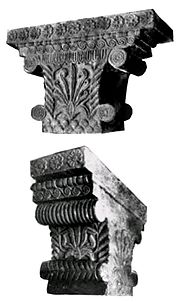Indo-Greek art Indo-Greek art is the art of the Indo-Greeks, who reigned from circa 200 BCE in areas of Bactria and the Indian subcontinent. Initially...
86 KB (9,302 words) - 17:40, 16 November 2024
The Indo-Greek Kingdom, also known as the Yavana Kingdom, was a Hellenistic-era Greek kingdom covering various parts of modern-day Afghanistan, Pakistan...
219 KB (26,014 words) - 07:41, 15 November 2024
needed] Buddhism became the prominent religion in the Indo-Greek Kingdoms. However, Greco-Buddhist art truly flowered and spread under the Kushan Empire,...
66 KB (7,013 words) - 09:29, 30 July 2024
coinage benefited from the help of Greek coin-makers. Indo-Scythian coins continue Indo-Greek tradition by using the Greek alphabet on the obverse and Kharoshthi...
53 KB (5,855 words) - 02:25, 7 November 2024
productions of the early Indo-Scythians, the Northern Satraps and the Western Satraps. It follows the development of Indo-Greek art in northwestern India...
61 KB (6,280 words) - 06:06, 25 January 2024
The legacy of the Indo-Greeks starts with the formal end of the Indo-Greek Kingdom from the 1st century, as the Greek communities of central Asia and...
44 KB (5,237 words) - 22:00, 24 June 2024
characteristic of Parthian art. Such palettes have only been found in archaeological layers corresponding to Indo-Greek, Indo-Scythian and Indo-Parthian rule, and...
34 KB (3,472 words) - 07:42, 23 November 2024
Indo-Greek art which had been flourishing between the 3rd century BCE and 1st century CE in Bactria and northwestern India, and the succeeding Indo-Scythian...
54 KB (4,826 words) - 10:14, 8 May 2024
the Classical pantheon of the Greek deities found on their coins (e.g., Zeus, Herakles, Athena, Apollo), the Indo-Greeks were involved with local faiths...
38 KB (4,352 words) - 00:10, 3 July 2024
process of reconstructing Proto-Indo-European myth. Despite the popularity of Greek mythology in western culture, Greek mythology is generally seen as...
141 KB (17,177 words) - 13:17, 12 November 2024
The History of the Indo-Greek Kingdom covers a period from the 2nd century BCE to the beginning of the 1st century CE in northern and northwestern Indian...
51 KB (6,471 words) - 13:31, 22 August 2024
impressive Greek achievements in philosophy, literature and other fields are well known. The earliest art by Greeks is generally excluded from "ancient Greek art"...
99 KB (12,649 words) - 19:03, 31 October 2024
Gandhara (redirect from Gandara art)
traditions of Gandhara art can be divided into the following phases: Indo-Greek art; 2nd century BCE to 1st century CE Indo-Scythian art; 1st century BCE to...
123 KB (13,697 words) - 15:14, 17 November 2024
Indo-European studies (German: Indogermanistik) is a field of linguistics and an interdisciplinary field of study dealing with Indo-European languages...
41 KB (3,965 words) - 15:41, 21 October 2024
art Architecture of India Indo-Greek art Gupta art Mauryan art Kushan art Hoysala architecture Vijayanagara architecture Greco-Buddhist art Chola art...
176 KB (17,473 words) - 23:57, 28 September 2024
Indo-Greek Kingdoms, with many noticeable influences on the arts of the Maurya Empire (c.321–185 BCE) especially. Hellenistic influence on Indian art...
49 KB (5,730 words) - 10:50, 7 November 2024
The Indo-European migrations are hypothesized migrations of peoples who spoke Proto-Indo-European (PIE) and the derived Indo-European languages, which...
267 KB (29,498 words) - 03:16, 21 November 2024
Greek (Modern Greek: Ελληνικά, romanized: Elliniká, [eliniˈka]; Ancient Greek: Ἑλληνική, romanized: Hellēnikḗ) is an Indo-European language, constituting...
69 KB (7,082 words) - 10:46, 22 November 2024
India Rasa (art) Other Indian Art and Architecture forms Architecture of India Indo-Greek art Art of Mathura Gupta art Mauryan art Kushan art Sundari painting...
87 KB (10,070 words) - 20:37, 15 November 2024
The following is a table of many of the most fundamental Proto-Indo-European language (PIE) words and roots, with their cognates in all of the major families...
341 KB (8,992 words) - 19:30, 21 November 2024
Greco-Buddhist art. Indo-Corinthian capitals display a design and foliage structure which is derived from the academic Corinthian capital developed in Greece. Its...
6 KB (589 words) - 12:41, 25 January 2024
Indian art Architecture of India Indo-Greek art Art of Mathura Mauryan art Kushan art Hoysala architecture Vijayanagara architecture Greco-Buddhist art Chola...
76 KB (8,424 words) - 04:02, 21 August 2024
Proto-Indo-European society is the reconstructed culture of Proto-Indo-Europeans, the ancient speakers of the Proto-Indo-European language, ancestor of...
78 KB (9,373 words) - 07:05, 21 October 2024
Greco-Buddhism (category Indo-Greek religions and philosophy)
"Two Hundred Years of Debate: Greek and Indian Thought". The Greek Experience of India: From Alexander to the Indo-Greeks. Oxford and Princeton: Princeton...
69 KB (7,722 words) - 18:19, 18 October 2024
reconstruct the history of the Indo-Greeks are few and disparate, leading to much uncertainty about the precise state of the Indo-Greek kingdom and its chronology...
41 KB (5,181 words) - 23:58, 24 July 2024
Proto-Greek language (also known as Proto-Hellenic) is the Indo-European language which was the last common ancestor of all varieties of Greek, including...
70 KB (6,787 words) - 03:56, 16 November 2024
Shunga Empire (section Art)
the Kalinga, the Satavahana dynasty, the Indo-Greek kingdom and possibly the Panchalas and Mitras of Mathura. Art, education, philosophy, and other forms...
53 KB (5,489 words) - 20:38, 23 November 2024
of Alexander the Great and later with the Indo-Greek Kingdom. A legendary account states that when the Greek God Bacchus/Dionysus grew up, he discovered...
12 KB (1,367 words) - 02:25, 7 November 2024
Greco-Bactrian Kingdom (redirect from Bactrian Greek)
sophistication. Greek art travelled from Bactria with the Indo-Greeks and influenced Indian art, religion and culture, leading to new syncretic art called Greco-Buddhist...
104 KB (8,571 words) - 01:29, 24 November 2024
cire perdue were found at the ruins at Sirkap. One example of this Indo-Greek art dates to the 1st century BCE, the juvenile figure of Harpocrates excavated...
53 KB (6,029 words) - 20:37, 15 November 2024






















